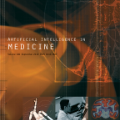The tendency to align to others is inherent to social behavior, including in animal groups, and flocking in particular. Here we introduce the Stochastic Alignment Problem, aiming to study basic algorithmic aspects that govern alignment processes in unreliable stochastic environments. Consider n birds that aim to maintain a cohesive direction of flight. In each round, each bird receives a noisy measurement of the average direction of others in the group, and consequently updates its orientation. Then, before the next round begins, the orientation is perturbed by random drift (modelling, e.g., the affects of wind). We assume that both noise in measurements and drift follow Gaussian distributions. Upon receiving a measurement, what should be the orientation adjustment policy of birds if their goal is to minimize the average (or maximal) expected deviation of a bird's direction from the average direction? We prove that a distributed weighted-average algorithm, termed W , that at each round balances between the current orientation of a bird and the measurement it receives, maximizes the social welfare. Interestingly, the optimality of this simple distributed algorithm holds even assuming that birds can freely communicate to share their gathered knowledge regarding their past and current measurements. We find this result surprising since it can be shown that birds other than a given i can collectively gather information that is relevant to bird i, yet not processed by it when running a weighted-average algorithm. Intuitively, it seems that optimality is nevertheless achieved, since, when running W , the birds other than i somehow manage to collectively process the aforementioned information in a way that benefits bird i, by turning the average direction towards it. Finally, we also consider the game-theoretic framework, proving that W is the only weighted-average algorithm that is at Nash equilibrium.
翻译:与其它方向一致的倾向是社会行为所固有的, 包括动物群, 特别是成群的。 我们在这里引入了“ 斯托切斯调整问题 ”, 目的是研究在不可靠的随机环境里指导调整进程的基本算法方面。 考虑那些旨在保持飞行方向一致的鸟类。 在每一回合中, 每只鸟都得到对组内其他鸟类平均方向的噪音测量, 从而更新方向。 然后, 在下一轮开始之前, 方向会受到随机流动( 模拟, 例如, 风的影响 ) 的困扰。 我们假设测量和漂移中的噪音都跟随高斯的分布。 我们假设测量后, 如果鸟类的定向调整政策旨在尽可能减少鸟类平均( 或最大) 方向与平均方向的偏离。 我们证明, 分散的加权算法是鸟当前方向与测量之间的平衡, 最大化的社会福利。 有趣的是, 我们通过这种简单分布的算法, 甚至假设鸟类可以自由沟通, 分享他们关于过去和当前测量过程的知识。 最终, 当鸟的算算算算算起来时,, 当我们算算算算算算得上, 平均方向时,, 平均的算算算算算算算算算算算算算算算算算算算算算算算算算算算算算算算算算算算,,,,, 最终算算算算算算算算算算算算算算算算算算算算算算算算算算算算算算算算算算算算算算算算算算算算算算算算算算算算算算算算算算算算算算算算算算算算算算算算算算算算算算算算算算。





